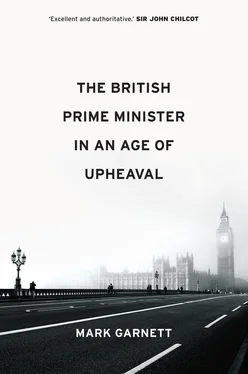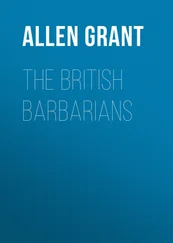Foley’s book could have appeared at a more propitious time. By 1993 Thatcher’s successor, John Major, was projecting a very different style of leadership. Arguably, then, even if a British ‘presidency’ had risen during the 1980s it had sunk along with Thatcher herself – indeed her downfall could be attributed to a reaction against her domineering style. This course of events seemed to verify the opinion of the former Foreign Secretary Patrick Gordon Walker, who wrote in 1970 that a Prime Minister who ‘habitually ignored the cabinet … could rapidly come to grief’ (Gordon Walker, 1972, 106). Normality seemed to be restored under Major, and for most political scientists ‘normality’ meant collective government. The membership of the ‘collective’ did not necessarily coincide exactly with the ministers who formed the Cabinet, but this had never been the case. Rather, the ‘core executive’ consisted of the Prime Minister and representatives of institutions which enjoyed ‘resources’ of various kinds – that is, ministers in the most important departments and their senior civil servants (see, for example, Rhodes and Dunleavy, 1993; Smith, 1999). The ‘prime ministerial/presidential’ approaches depicted politics as a ‘zero-sum game’, in which an accretion of power for the Prime Minister entailed a corresponding loss for other actors and institutions. The ‘core executive model’ rejected this picture, presenting the relationship between the Prime Minister and senior colleagues as one of mutual dependence and co-operation. There was room in the core executive model for special advisers, too, but these relative newcomers to the political scene were not regarded as very significant since their ‘resources’ depended on ministerial favour – that is, if their political employers were unhappy with their services, their influence could be ended abruptly.
By the end of the millennium events had moved on, and in 2000 Foley published a new version of his book with a defiant title ( The British Presidency ) which suggested that his interpretation was now established fact rather than a provocative hypothesis. His argument was based chiefly on the first Blair Government (1997–2001), whose practices seemed in many respects to transcend Thatcher’s tentative ‘presidential’ steps. However, as Foley himself knew very well, any claim that Britain was governed by a President was bound to run into the objections that its head of government was a constitutional monarch, and the Prime Minister (unlike a President) was directly responsible to Parliament. Foley’s readers would be aware that he was trying to identify presidential features which had crept into a system whose formal constitutional status had not changed. However, his titles (and, often, his style of writing) gave a contrary impression; and others were less equivocal in their equation of New Labour with ‘presidential’ government. Indeed, the emphatically un-Blairite Labour MP Graham Allen published a very lively tract arguing that it would be much better for Britain if it implemented a formal presidential system of government, rather than suffering from the drawbacks which inevitably arose from a hybrid presidential/parliamentary system (Allen, 2003).
Despite Blair’s presidential style the core executive approach was still generally accepted among political scientists at the time of his resignation in 2007 (Diamond, 2014, 193–213). It received timely support from scholars, notably Andrew Blick and George Jones, who found plentiful precedents for contemporary developments, even in the practices of the earliest Prime Ministers like Walpole and Pitt the Younger, who had employed the ancestors of today’s ‘spin doctors’ and special advisers (Blick and Jones, 2010). While invaluable from an historical point of view, this plus ca change approach could be countered by the argument that examples drawn from the period before universal adult suffrage (1928) related to a very different political context. Since then, the exigencies of ‘total war’ would have promoted a lasting enhancement of the Prime Minister’s role, even under a premier with none of Churchill’s relish for supreme command, or Clement Attlee’s eagerness to exploit what remained of the wartime spirit in order to push through a socio-economic revolution.
Since 2003 the debate has continued but in a more subdued and nuanced fashion. While rejecting the ‘presidential’ thesis, most contributors have accepted that the Prime Minister’s role has been strengthened (e.g. Heffernan, 2005; Dowding, 2012). The resulting scholarship has enhanced understanding of British politics in general, but it still reflects the preoccupation of political scientists with definitions, models and institutional comparisons. It is a common refrain in the academic literature that the role of the Prime Minister is still ‘under-theorized’. It could be argued to the contrary that much of the work on the Prime Minister emanating from political scientists suffers from an excess of theory, being conducted within analytical frameworks which downplay other considerations (in particular, Britain’s relative decline as a global power, and the influence of the media; see Rose, 2001)), and draws too heavily on formal interviews tinged (even tainted) by hindsight, rather than contemporary media reports or the published diaries of key participants.
While the core executive approach is a valuable corrective to the notion that the Prime Minister can govern without co-operation of some kind, this is an unavoidable feature even of undemocratic states and thus cannot shed much light on the way in which the role has developed since 1979 (Brown, 2010). The core executive model focuses on the distribution of power – that is, in simplistic terms, the ability to get things done, for which co-operation (willing or not) is obviously needed. In Britain, the realization of most policy objectives (better health care, higher standards of education, etc.) cannot possibly be effected by a single person, but depends on co-operation at all levels down to nurses and classroom teachers. The argument presented here is that a more relevant question relating to the Prime Minister is that of prominence , particularly in terms of electoral politics. This is much more compatible with a zero-sum game; if the front page of every newspaper features a photograph of the Prime Minister, his or her colleagues are being denied equal publicity, even if they are making more noteworthy contributions to governance.
A book which is more concerned with prominence than power is suggested by other developments in the academic literature. For example, Rod Rhodes and others have investigated developments within the British state, which in their view has been ‘hollowed out’ in recent decades (e.g. Rhodes, 1994; Campbell and Wilson, 1995). This seems difficult to square with the core executive model, since it implies that ministers and government departments have been losing their ability to effect constructive change and hence have fewer ‘resources’ at their disposal. On the face of it, this does look like a significant shift in the Whitehall power-game; if ministers have lost status and authority, the same is not true (at least directly) of the Prime Minister, who has no departmental responsibilities. If governmental capacity has weakened, more onus would be placed on the Prime Minister to create the impression of success, for vote-winning purposes. On a related theme, Patrick Diamond has argued persuasively that, having been seriously affected by the hollowing out of the state, civil servants now increasingly find themselves being ‘politicized’ – that is, working to enhance the popularity of the party in office, rather than pursuing what they conceive to be the national interest (Diamond, 2018). Looking back over the period since 1979, it is difficult not to hanker after the days in which departmental ministers and their civil servants really did enjoy ‘independent resources’; in terms of the ability to achieve constructive results (and to palm off responsibility when things go wrong) Prime Ministers themselves would be better off if this were still true.
Читать дальше












